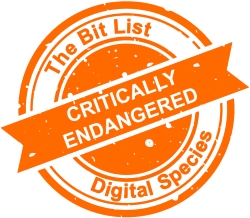Smart TV Apps
 |
||
|
Apps created for smartphones. Many are deprecated quickly but others survive through multiple update cycles. It is hard to maintain version control and often dependent upon the company that publishes them. There is no clear agency or mandate to record or collect. |
||
|
Digital Species: Apps |
Trend in 2024:
|
Consensus Decision |
|
Added to List: 2023 |
New Entry |
|
|
Imminence of Action Action is recommended within twelve months, detailed assessment is a priority. |
Significance of Loss The loss of tools, data or services within this group would impact on many people and sectors. |
Effort to Preserve | Inevitability Loss seems likely: by the time tools or techniques have been developed, the material will likely have been lost. |
|
Examples UlangoTV; ITV Hub; Plex; apps created for older or no longer manufactured TVs. |
||
|
‘Practically Extinct’ in the Presence of Aggravating Conditions Device dependence; poor documentation; lack of preservation interest or mandate by company; uncertainty over IPR or the presence of orphaned works; deletion of stores or apps. |
||
|
‘Endangered’ in the Presence of Good Practice Strong documentation; development of tools to archive stores and preserve menus online via the WARC format, and for HTML5 and Flash-only based smart TV media; designated repository taking preservation responsibility and capacity to deliver. |
||
|
2023 Review This was a new Bit List entry added in 2023 to draw attention to the particular challenges of content and software preservation for apps designed and used for smart TVs. While there are some similarities with the ‘Smartphone Apps’ entry in regard to device dependency, frequent updates, and lack of preservation interest or mandate by companies that publish them, this entry focuses on the distinct risks relating to the availability and access to apps made specifically for smart TVs, which can be more short-lived, variable, and challenging to access and find a rootable version for preservation actions. These apps, designed and used specifically for smart TVs, are deprecated quickly or undergo frequent updates. It is challenging to maintain version control and preserve the content. Preservation efforts often depend upon the availability and access to rootable versions of the apps by the companies that publish them, particularly for older TVs that are no longer manufactured. There also remains a lack of clear agency or mandate to record or collect from corporate owners and barriers to access for preservation efforts outside this context. The 2023 Bit List Council recommended that the next major review consider creating a new Broadcast species group where this entry may be better suited. Council members additionally noted that it may be better to have a broader entry for smart device apps rather than specifically ‘Smart TV Apps’ and ‘Smartphone Apps’ as separate standalone entries. The risks posed by these apps can apply to a variety of devices; for example, before Smartphones, there were PDAs, and there are now Smart fridges, set-top-boxes, fire sticks, e-book readers, and other devices which have apps. For this reason, they recommended that the next major review for the Bit List includes a rescoping of Smart TV Apps and Smartphone Apps to consider: What differentiates these apps from others? What cultural heritage purpose do these apps serve? Are organizations collecting them? Are there distinct aggravating factors or risk profiles? |
||
|
2024 Interim Review These risks remain on the same basis as before, with no significant trend towards even greater or reduced risk (‘No change’ to trend). |
||
|
Additional Comments In regard to preservation actions, rooting methods for old smart TVs are often non-existent or hard to do (and sometimes manageable when they do exist); it is challenging to buy or find owners of older smart TV units with removed-from-the-store apps that have rootable versions and/or is willing to root. The content these apps contain can hold social and cultural significance; they can provide a history of television, entertainment, and exclusive or unique content only made available through the apps specifically designed for smart TVs. Although there is a small community of people interested in old smart TVs and a bigger one focused on new ones too, in the future, when the technologies become even more obsolete, there will be researchers and others interested in looking back at Smart TVs as a piece of the history of entertainment and even culture. Case Studies or Examples:
|
||





































































































































